Get branding tips and expert advice delivered straight to your inbox.
Filecamp is advertised as a "lightweight and low-cost" digital asset management software that mostly appeals to small businesses and creative professionals. They offer all of the core DAM features to store, search, and share digital assets, and have a few extras like automated tagging, custom branding, and guest upload links.
Despite its many features, enterprise and global teams shouldn't use Filecamp (or any other low-cost DAM) because the features are basic and the platform isn’t built to accommodate a large volume of assets. (Users often tell us it slows down and gets buggy as your library grows.) Not to mention, Filecamp doesn’t offer critical features like integrations or CDNs to distribute and monitor assets across many channels.
In short, Filecamp works best in the long-term for small brands that expect to stay small. If you need scalability, you need a more robust DAM.
Brandfolder has customizable set-up options so you can choose storage space, select the number of seats you need, and connect integrations. You can modify the platform as you go. Forrester gives Brandfolder’s scalability a 5/5 rating. Although most of our customers are mid-size and larger teams, small businesses that are ready to invest in DAM software can make the switch with Brandfolder and tailor the DAM to their current needs.
In this post, we talk about:
Brandfolder’s core digital asset management features.
Extras like templating and online publishing tools to help you repurpose digital assets and improve speed to market for digital campaigns.
Customization options to tailor Brandfolder to your specifications.
At the end, we’ll review four other DAM software and explain who they’re typically recommended for (based on information from customer reviews).
Brandfolder has advanced digital asset management features to store content, retrieve files, help discover related assets, share files online, repurpose collateral for new campaigns, and monitor all of your assets and how they’re used. Schedule a free demo with our team to walk through our DAM and see how it can be set up for your business size and workflows.
#1 Filecamp Alternative: Brandfolder’s Scalable DAM
Brandfolder is consistently mentioned in best DAM software reviews. We have a 98% customer retention rate because our digital asset management solution is the closest thing to "tailor-made" — you specify seats, storage, integrations, and add-on features and adjust as your needs change. It’s not designed for just one type of user or business size.
Plus, we have a hands-on customer experience team to guide you through onboarding and help you make adjustments to your Brandfolder in the future. So instead of pigeonholing you into pre-set packages and leaving you paying for more than you need, we tailor Brandfolder to you.
On top of this flexibility, Brandfolder provides advanced features that help you do more than just store and search files, we have tools so teams can download, edit, and use brand collateral. Our platform facilitates self-service, eases the burden on creatives, and lets everybody use content faster and more strategically.
In these sections, we’ll talk about Brandfolder’s features to store, use, and monitor assets.
Cloud Storage & Advanced Search and Discovery
Brandfolder is a no-code, secure cloud storage platform and accepts hundreds of file types so you can store everything from images and documents to 3D models, videos, RAW photos, and design files. Our team helps with the switch so we can provide tips to organize digital assets and even configure Brandfolder to automatically place assets as you upload.
The organizational structure in Brandfolder is similar to the folder/subfolder hierarchy we’re familiar with in other cloud storage drives for business.
You can use Brandfolders to organize files by business/brand/organization. Within Brandfolders, you can create Collections to organize groups of related assets and Brand Portals to centralize relevant files for end-user groups.
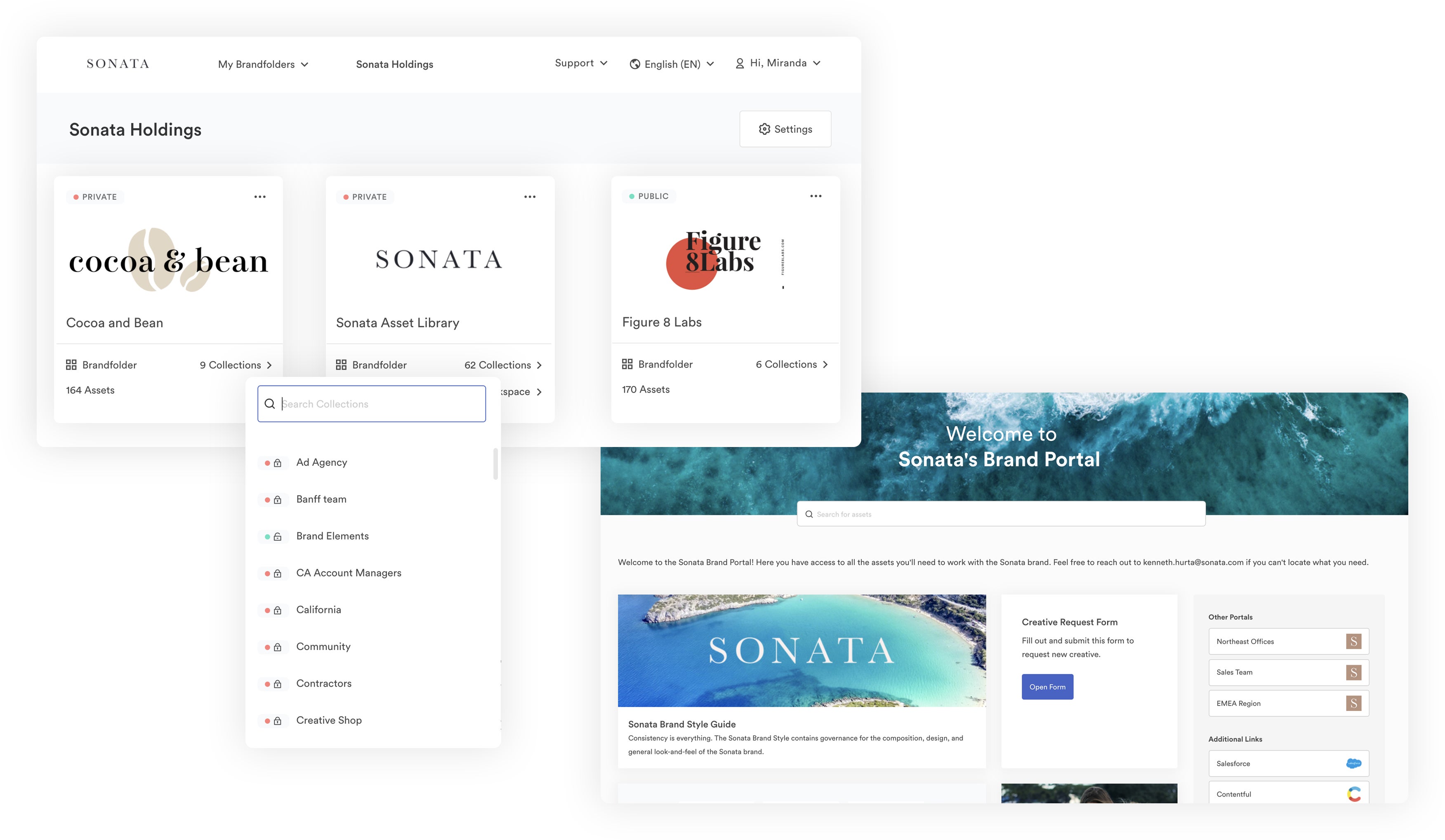
For example, say you’re an agency setting and managing marketing assets for a dozen brands: You can create Brandfolders for each brand, Collections to organize content by project or campaign, and Brand Portals to distribute assets to clients and partners.
Brandfolder also has a flat digital asset management taxonomy, enabling you to store assets in multiple Collections or Portals without creating new versions or duplicates. You can simply drop an asset in both a Collection and a Brand Portal, and all users can view and work off of the same version of the file.
As you upload files to Brandfolder, our artificial intelligence — Brand Intelligence — scans the content of your files and automatically adds metadata and tags. You can also store other relevant asset information in the overview, such as copyright or digital rights management information and instructions to use the asset. All overview details are shared with end-users when you share assets.
We have features to keep your asset library updated and improve version control:
Expirations allow you to set a date to automatically retire assets. Expired assets still live in your DAM library, but they’re marked as unavailable so other users can’t download or share them. Automatic expirations give you better control over the content lifecycle and prevent outdated collateral from sneaking into new projects.
Duplicate asset detection prevents users from uploading files that already live in your library. Brand Intelligence scans all new uploads and alerts you if the upload matches an existing file; when it detects a dupe, users are prompted to cancel the upload or merge the file with the "parent" file in Brandfolder. Then, related files are stored together in the asset container so you don’t have multiple variations of files cluttering the main library.
User permissions (more on this in the next section) allow you to add other users to Brandfolders, Collections, Portals, or selected assets, and control how they can engage with your content. For example, you can add everybody on the design team to Brandfolder as "Collaborators," and then they can upload new content, approve uploads and updates, and expire or delete old assets. These permissions let you control who’s adding, editing, and removing content from your DAM so no unapproved uploads slip through the cracks.
Brandfolder also has an intuitive and fast search functionality — just type in a word or phrase and Brand Intelligence scans your entire asset library for everything that’s relevant. You can find specific files or discover new content that’s related to your query; there’s no digging around in folders or racking your brain for exact file names. You can also use advanced filters to narrow down your search results or browse your library with Labels (to search by asset classification) and Pin (to search by metadata tags).
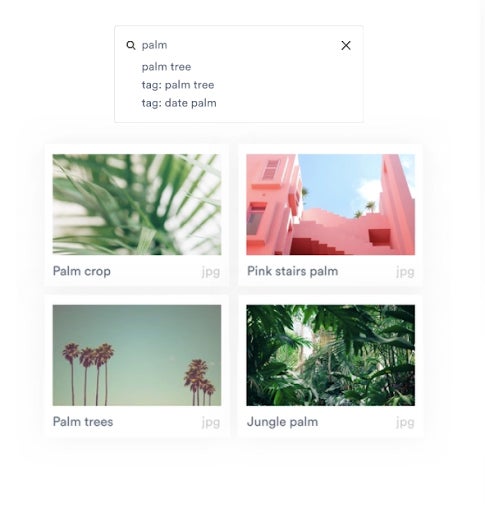
Read More: With the Right DAM, You Won't Need File Naming Best Practices
Online Sharing Features & Tools to Monitor Sharing
As we discussed just above, user permissions let you share with other Brandfolder users and control what they do with your brand assets. These give you granular access control and contribute to maintaining organization in your DAM library. There are three main user roles: Admins can add and remove users; Collaborators can add new content, approve uploads, and remove assets; Guests can view and download assets.
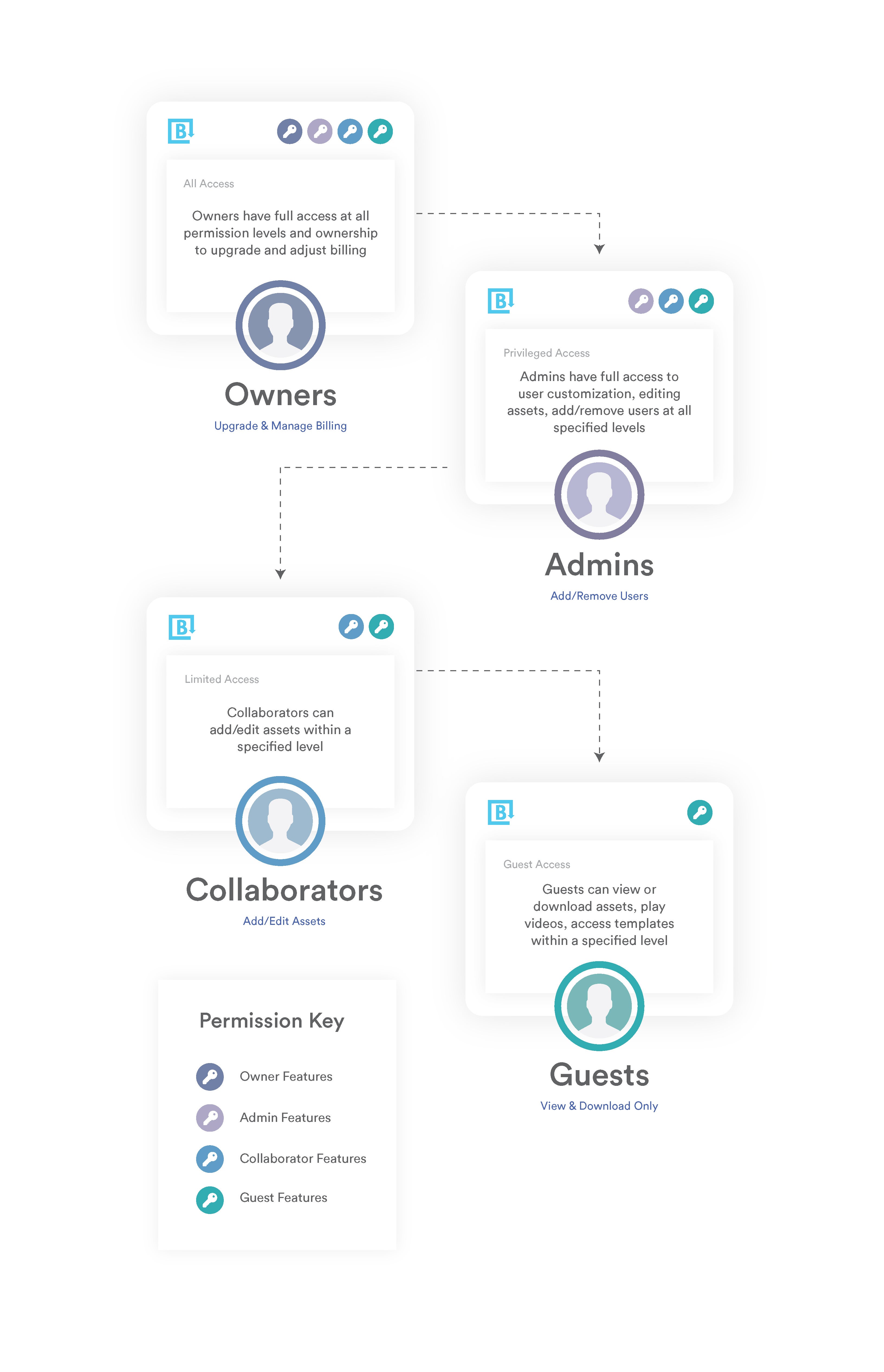
We provide free unlimited guest seats, so there are no sharing restrictions — you can share with other Brandfolder users or people outside of your organization without extra charges. This perk is especially important for large and enterprise businesses that frequently share assets and collaborate with agencies and partners, as they don’t have to budget for sharing fees.
Read More: Five Criteria to Evaluate Enterprise Digital Asset Management Software
We also have custom share links to share digital assets with external users. Share links work across email platforms, messengers, workspace collaboration tools, and even SMS, so you can copy the link and share it with anyone — this takes the hassle out of sending large files like videos to other users. You can use share links to send entire Brandfolders or Collections, or you can choose specific assets to share. You can also add or remove assets from these share links any time you need. (Assets will automatically update across share links if you make edits in Brandfolder, too, so you don’t need to re-share assets once you’ve sent the original file.)
These share links give you better control over your content after you send it off. For example, you can watermark assets, disable downloading (or enable view-only or request-only for downloads), block users from viewing assets until they submit their email address, and set links to expire.
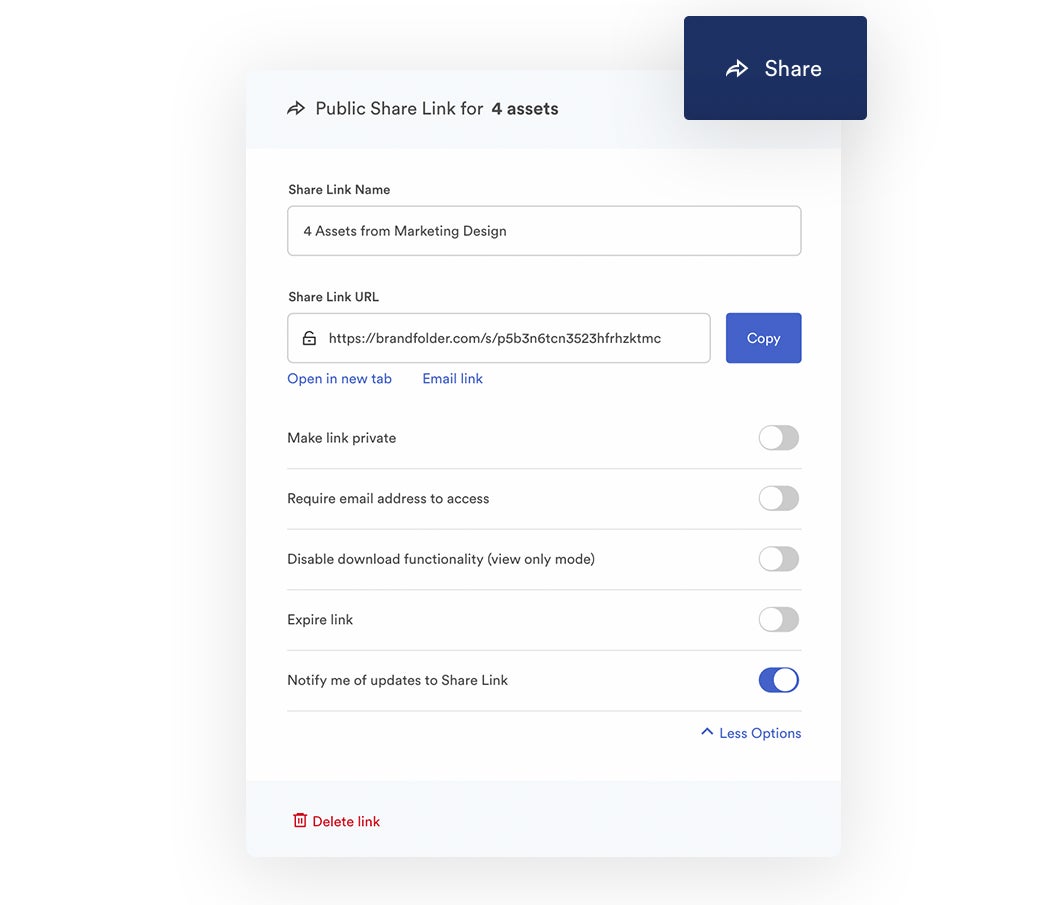
Brandfolder supports dynamic viewing and will automatically optimize assets for the end user's device and location, so you can share with users all around the world and they can engage with your content in their preferred format.
You can monitor all active share links and see more details about what’s been shared, with who, and when, all in Brandfolder’s reporting dashboard. You can also expire share links from within this dashboard, this way you don’t leave content available for end-users who aren’t authorized to (still) have it.
Advanced Features to Edit & Repurpose Assets
Brandfolder provides tools so users can edit and repurpose assets within the DAM dashboard. For starters, we have a collaborative workflow tab where team members can comment back and forth with each other about asset updates. Then, collaborators can "check out" assets for updates and push them back to their native editor. Once changes are complete, editors can push the asset back to Brandfolder for review and approval.

The updated version of the asset becomes available for other users once it’s approved, and Brandfolder records the entire version history so you can see past edits or revert assets.
Read More: Need Better Image Version Control? Use a DAM
Beyond updating assets, Brandfolder also has a built-in templating feature where designers can import pre-approved templates from InDesign and other users can repurpose those templates for unique projects.
Designers can control how templates are personalized, so nobody goes off-brand. Users can drop images or videos into these templates and add custom text. For example, you could create templates for marketing collateral like online ads or flyers and then members of your marketing team can personalize them for different campaigns or locations.
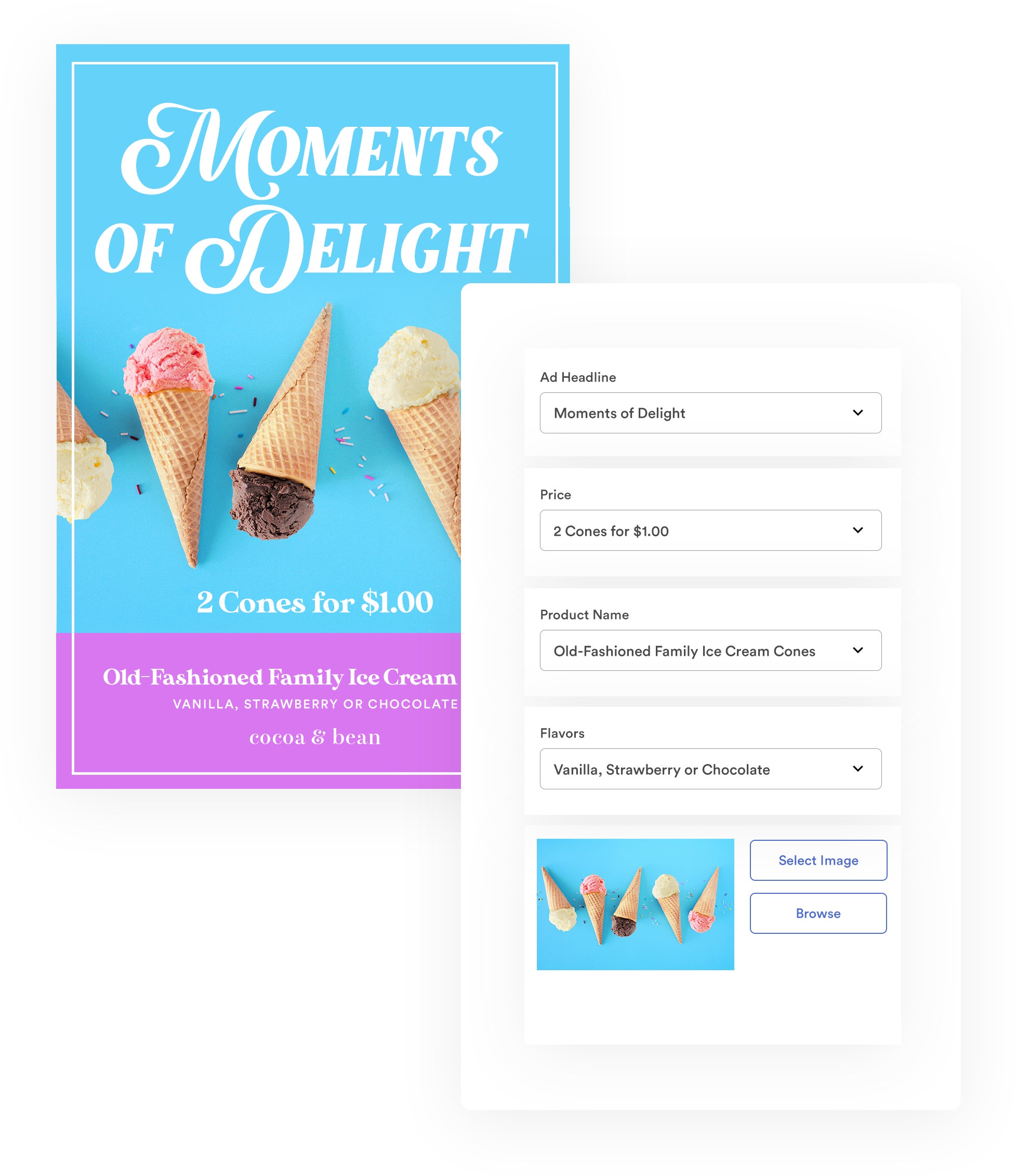
We also offer tools like convert and resize so you can modify an asset's file format or resolution before downloading. In addition, the custom and preset crop tool lets you crop assets for different platforms on the fly. We have preset crops for sites like Facebook so you can easily make cover photos or ads, but you can also create custom crops to optimize assets for other sites, like your website or blog.
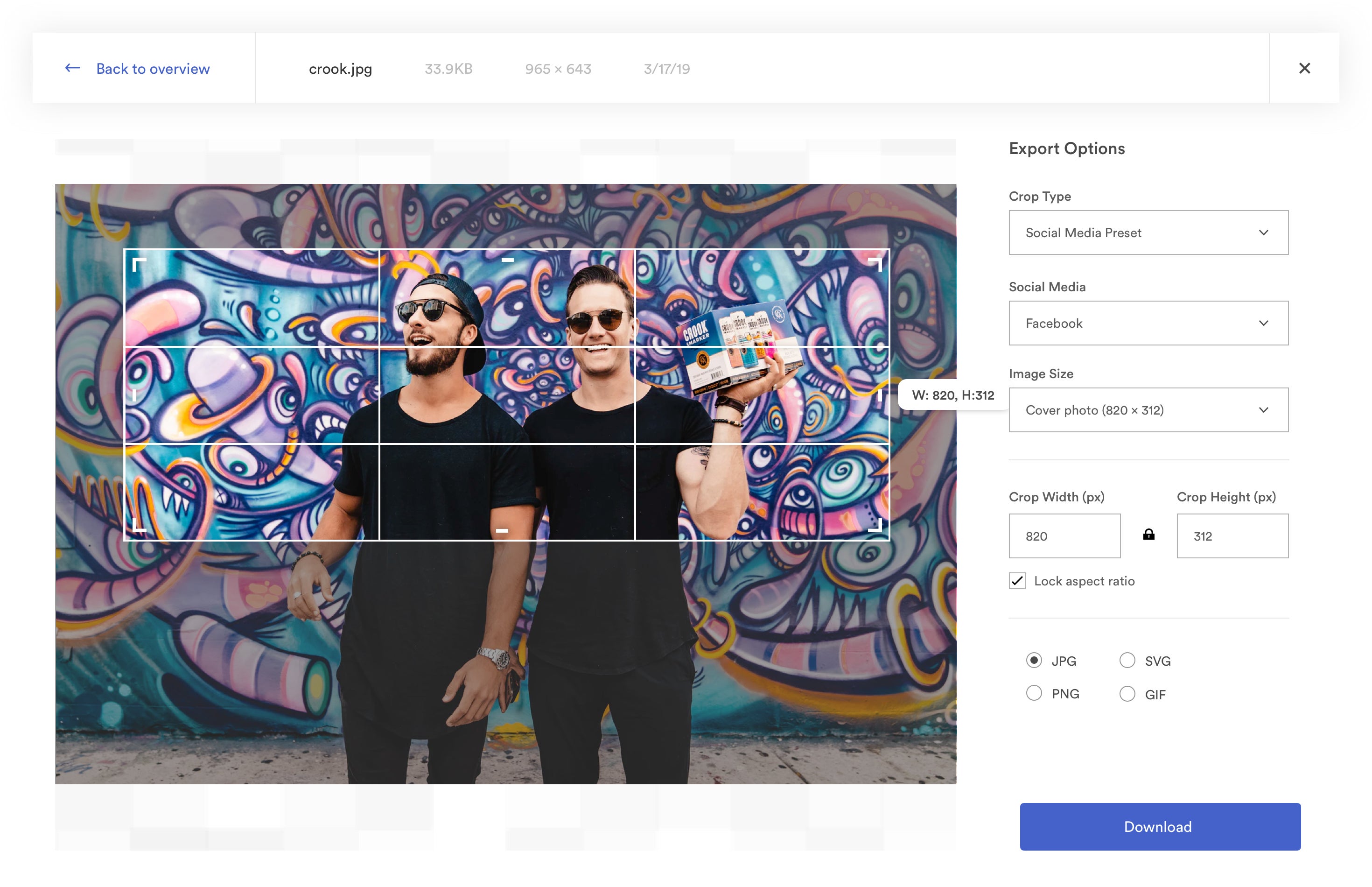
Brandfolder is unique from other DAMs, like Filecamp, because we have a robust video studio within our platform where you can create video clips or GIFs for social media, trim video, watermark video, and create video thumbnails. We also transcribe all of your video footage to text so you can view your video transcript and search video content by dialogue.
Brandfolder integrates with advanced editors (like Adobe’s video editing software) so you can easily push video files back and forth if you want to make in-depth updates or add special effects to content.
Lastly, Brandfolder offers a Brandguide feature that lets you publish and distribute brand guidelines to all of the end-users who have access to your digital assets. This feature improves brand consistency, as publishing brand guidelines guarantee everyone has the necessary information to use assets correctly. You can get as detailed as you want in these guidelines; some teams keep it brief while others cover everything from brand voice to instructions for publishing content online.
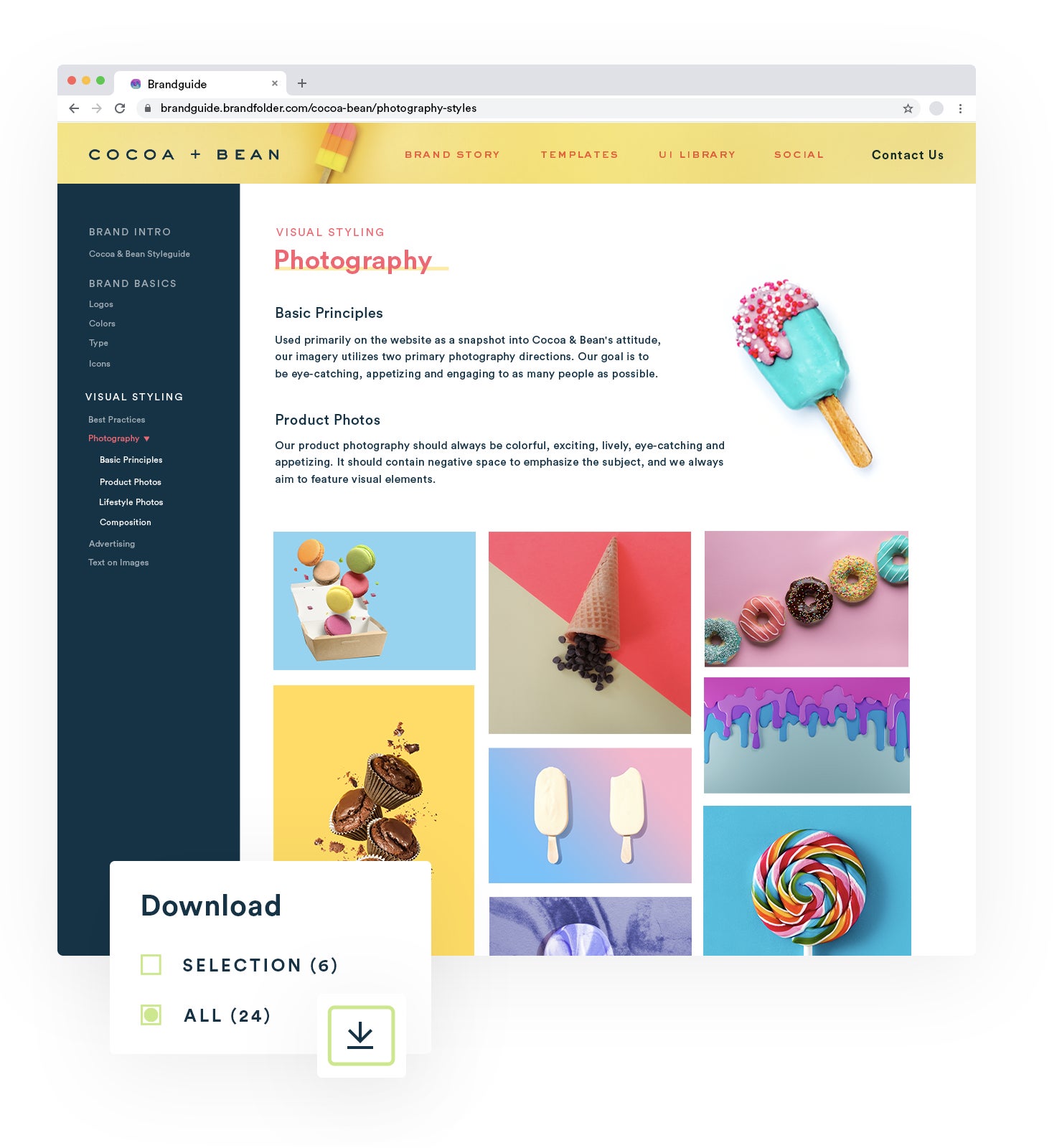
Reporting to Track Digital Assets
Brandfolder Insights lets you monitor asset usage and shows you important user activity like who is most active in your DAM. The reporting dashboard even displays a real-time activity feed so you can see what other users are doing in the DAM at all times.
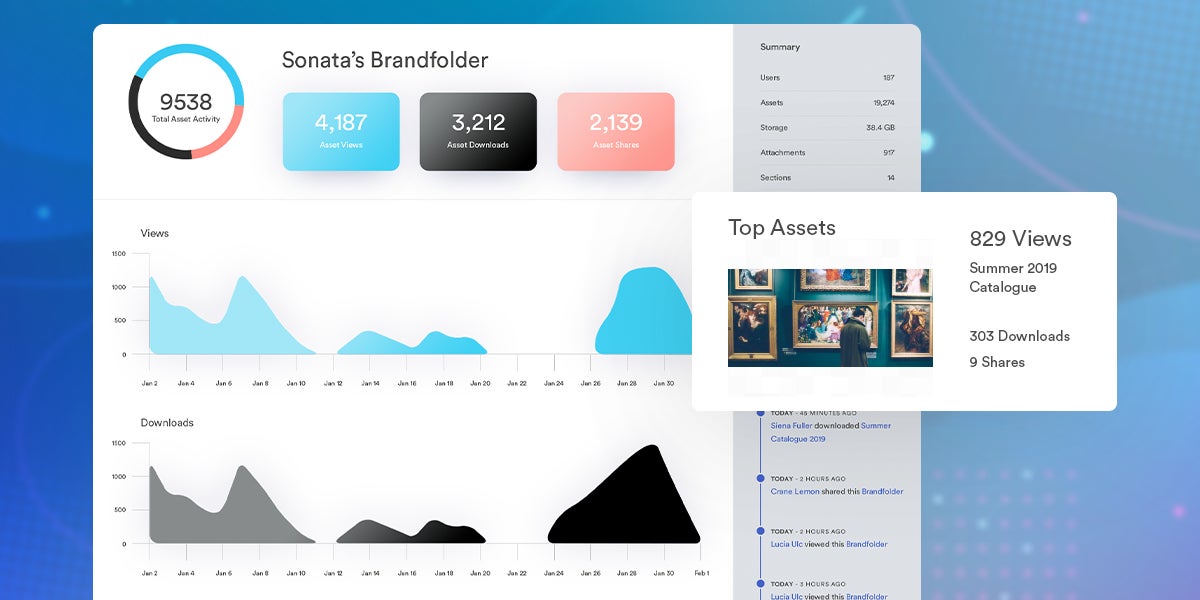
Within Brandfolder’s reporting dashboard, you can see reports like "Top Performing Assets" and “Top Users”, and look at specific files to see how many times an asset has been viewed, downloaded, or shared. We give each asset a “Health Score” so you can see how successful it is with your users (i.e., whether the asset is commonly used or often overlooked).

You can also look at active share links and CDN links in this dashboard and see who has access to your content and where it is published online. You can expire these links if you need, making brand management tasks easier.

Integrations to Connect Your Tech Stack
Brandfolder has an open-source API and dozens of native integrations so you can connect your digital asset management platform with other software you use in your workflows. Then you can send content to Brandfolder or push files to other systems without downloads, uploads, and duplicates.
For example, you can integrate Brandfolder with:
Content management systems like WordPress to publish assets on your blog.
eCommerce sites like Shopify to add content to product pages.
Project management software like Smartsheet so you can sync data between systems and keep everybody on the same page.
Content creation tools like Adobe Photoshop & InDesign so you can import files directly from the native editing tool (and send files back for updates).
Workspace collaboration tools like Slack and Microsoft Teams so you can quickly receive and send assets.
Marketing communication tools like Hootsuite and HubSpot to improve speed to market for campaigns.
Read More: The Best DAM Project Management Solution: Brandfolder
Brandfolder also has a content delivery network (CDN) system so you can use your DAM as a single source of truth and publish content directly from Brandfolder. Then, as we mentioned above, you can track active CDN links in the reporting dashboard and better oversee online publishing.
Lastly, Brandfolder offers a web-to-print integration with Gelato. For example, say you manage a retail brand and use Brandfolder’s templating feature to make flyers for an upcoming event, you can use this integration to create a custom print order and ship the flyers to all of the participating locations.
Brandfolder integrations help everyone work with brand content more efficiently and they guarantee everybody is using the approved, current versions of assets.
Adjust As You Go
Brandfolder can accommodate mid-size and enterprise teams, as well as small businesses that are ready to move to DAM software because it's customizable and flexible. You can modify the platform at any time to support your current needs, adjust storage space as your library grows, add or remove users, set up new integrations, or update to access advanced features. Our team can help you make any changes when you’re ready.
Although switching to DAM software feels overwhelming, we walk you through the entire process, and Brandfolder has a user-friendly interface and features so you can learn how to use the platform without much downtime. (We also have tutorials on our YouTube page if you get stuck or want to learn about new features.)
You can learn more about switching to Brandfolder in our guide: 10 Digital Asset Management Best Practices From DAM Experts
You can also schedule a demo of Brandfolder to meet with an expert from our team and discuss your goals with moving to DAM software. We’ll talk about how to customize Brandfolder for your specifications and gameplan migration.
Four Other Filecamp Competitors to Consider
In addition to Brandfolder, there are a number of other digital asset management platforms that are suited for mid-size and enterprise companies. In this section, we review some of the most popular names you’ll see on Filecamp competitor lists.
Canto
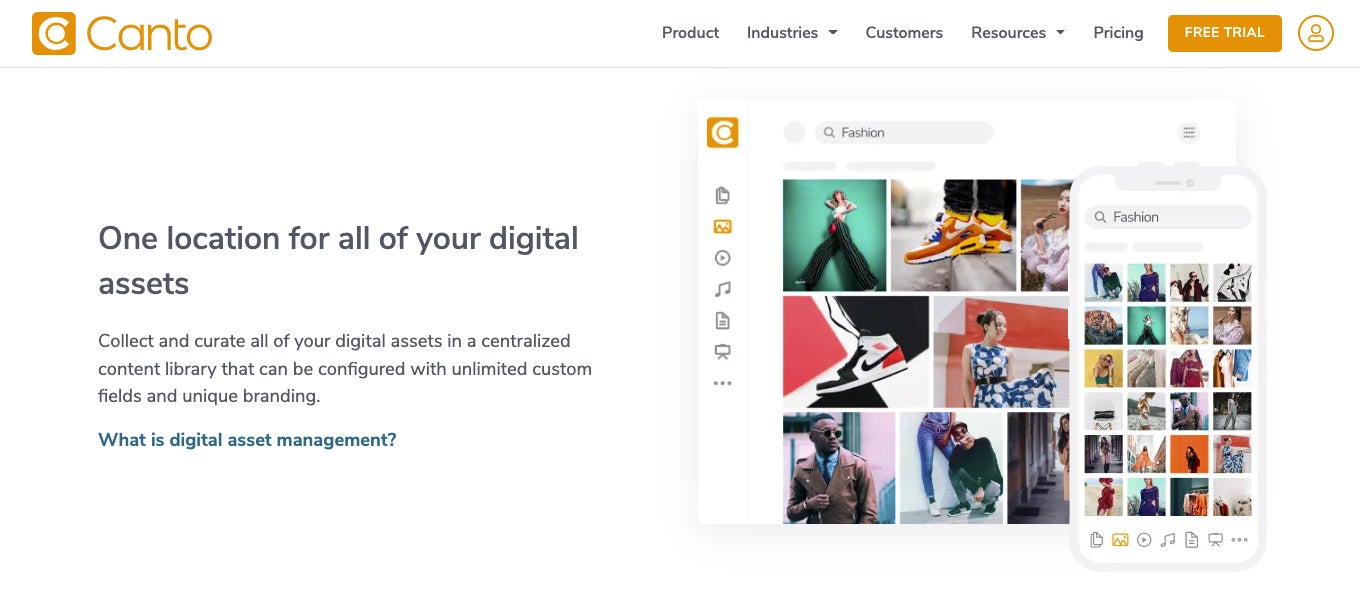
The first option on our list, Canto, is a DAM that is traditionally recommended for small businesses and startups but now offers more robust features, like branding options and collaboration tools, that appeal to larger teams.
(However, larger teams note that the cost of using Canto’s features can add up — for example, Canto offers external sharing features and options to monitor file sharing, but they charge for every guest seat, so you have to pay extra to take advantage of those features.)
Canto’s DAM offers all of the basics in terms of storing, searching, and sharing assets, and they also offer reporting features, native integrations with other software, and extras to help teams use assets in new projects.
However, negative reviews of Canto mention that it can be hard to maintain organization in your asset library as you acquire new content and add more users. Reviews also mention that Canto’s interface is a little outdated and cluttered despite recent updates.
You can read more about Canto and how it compares to Brandfolder in our buyer’s guide: Canto Software vs. Brandfolder: Compare Two Top-Rated DAMs
Bynder
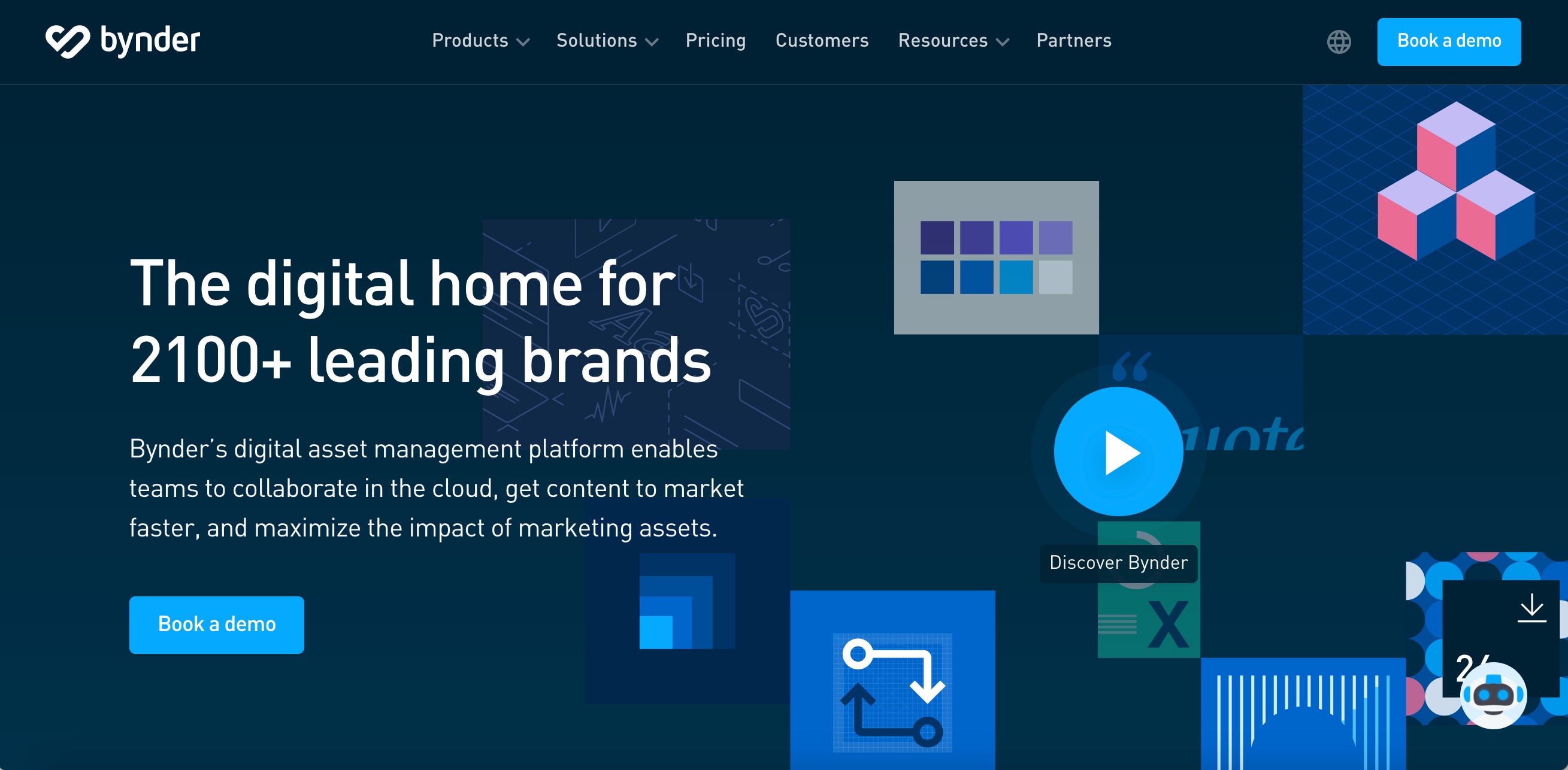
Bynder offers two digital asset management software: The core DAM Bynder and a tool called Webdam that’s designed to help creatives and marketing teams manage digital projects; note that these are sold separately.
Reviews of Bynder say that it can work for various business sizes, but it’s mostly suitable for larger teams that have the budget for a robust DAM.
Bynder is often compared to Brandfolder because we have similar features. For example, both Bynder and Brandfolder have automation rules, templating options, and tools to publish brand guidelines in the DAM. However, reviews of Bynder say it’s not the easiest DAM to learn or use, and some reviewers say it can be hard to get assistance from Bynder’s team, so you’re mostly on your own to navigate set-up and learn the software. While large teams with resources can work around this, it can pose a problem for smaller teams that want to get started with something quickly (and this is another reason why Bynder is recommended for enterprise businesses).
Overall, Bynder gets good reviews and offers customization options so you can sync the software with other applications and specify storage space. Just keep in mind that it can be costly for smaller teams and onboarding may pose some challenges.
Read More: Bynder Alternatives: How Brandfolder & Other Competitors Compare
MediaValet
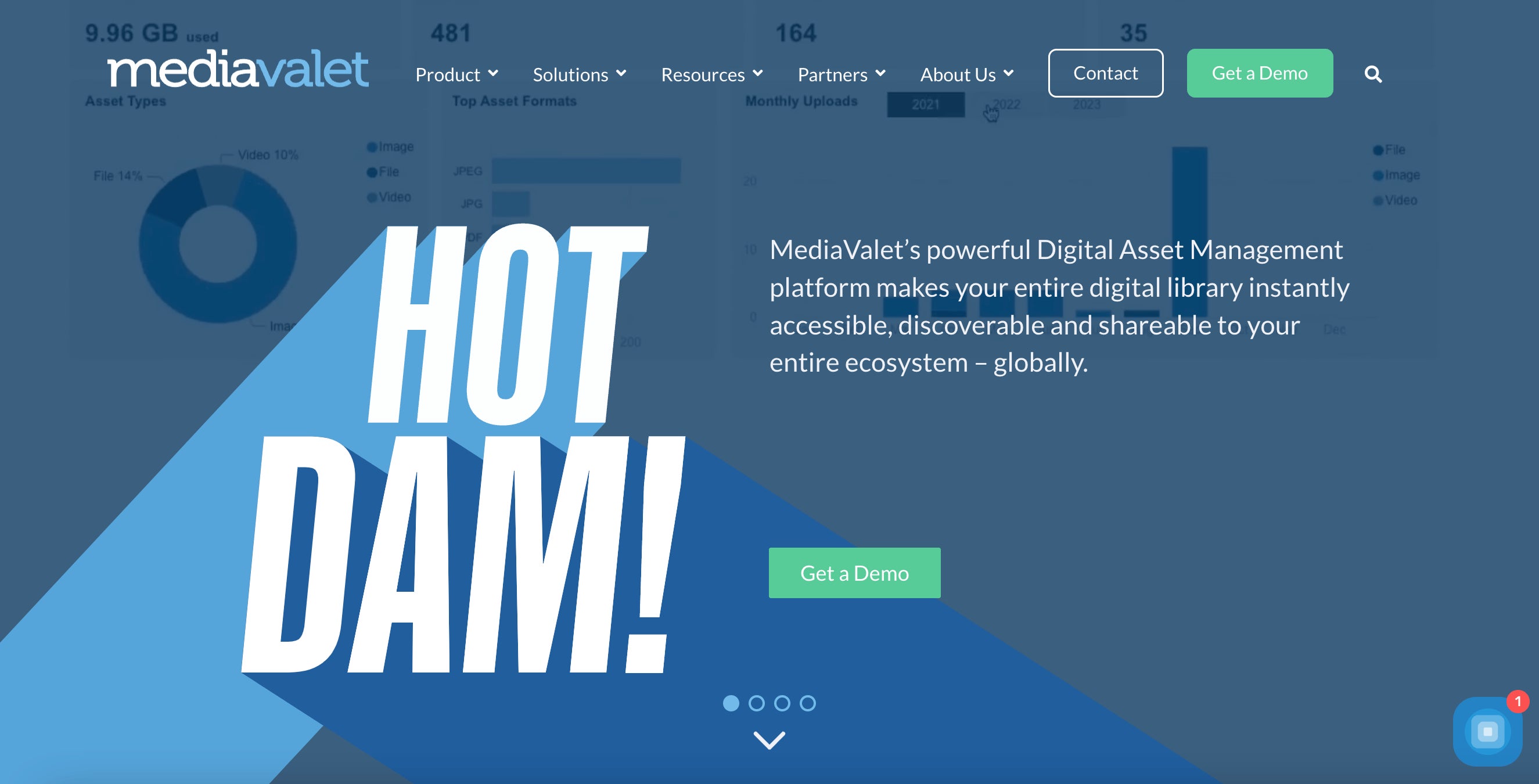
The next name on our list, MediaValet, is a DAM designed for enterprise and global teams; it has advanced features to store assets and archive old content, and extras like a video dashboard to edit rich media files. Enterprise businesses also like MediaValet because they allow for unlimited users, so you can add as many people as you need as your business grows, and they provide training and support to aid with adoption.
MediaValet mostly appeals to creative and design teams, but they advertise their solution for industries like healthcare, hospitality, and higher education (to cover a variety of bases).
Although MediaValet is flexible and customizable, it's still too costly for most small and mid-size teams, and some reviewers are unhappy with the steep costs when the software experiences bugs or glitches. Plus, reviewers say MediaValet can have slow loading times, especially when you have a high volume of assets, and the search feature doesn’t always find what you need.
Aside from high costs and some glitchiness, MediaValet earns positive reviews from customers — they just don’t offer the friendliest pricing options for small and mid-size teams to get started with a digital asset management system.
Widen Collective
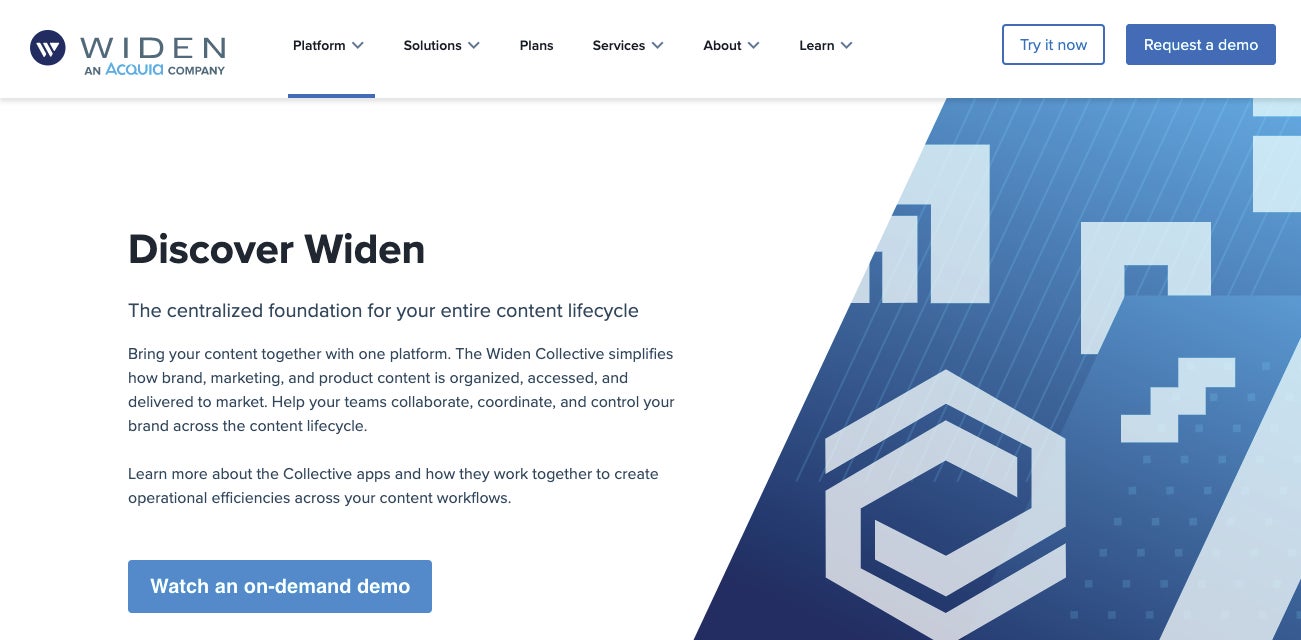
Widen Collective is an enterprise digital asset management + product information management (DAM + PIM) solution for teams that need robust functionality in both departments.
DAMs can help you store basic product information with assets — for example, you can add product details in custom fields or the asset overview — but product information management software is far more in-depth and centralizes all technical and relevant product information. It’s mostly used by enterprise eCommerce and retail teams that have a large inventory or sell products through multiple channels (i.e., website and Amazon storefront).
In addition to the primary digital asset management tools like cloud storage, online sharing, and fast search, Widen has extras including a reporting dashboard, templating feature, and web-to-print feature. For the most part, Widen is a top-rated DAM and receives positive reviews.
That said, Widen isn’t the best option for teams that don’t need the extra product information management components because they’ll end up paying for features they don’t need or use — and Widen isn’t necessarily budget-friendly. Plus, Widen charges extra for integrations and support, so there’s a cost to customization.
In addition, Widen is one of the most complex DAMs available so it takes some time to learn. They offer "Widen University" training tutorials to help teams navigate the features, but some downtime is expected to get users fully adjusted. So if you’re a big business with the budget and resources for Widen’s product, you can benefit from having the DAM + PIM functionalities; however, teams that just want DAM software can find a more cost-effective solution.
Read More: 6 Best Alternatives to Widen Collective: Buyer's Guide
Get Started with a Brandfolder Demo
Brandfolder is a customizable and scalable DAM that can accommodate small teams that are ready to move to DAM software and large businesses as they grow. We were even voted as a DAM leader by G2 for small, mid-market, and enterprise companies — and we’ve been recognized for our usability and fast implementation.
Once you’re set up in Brandfolder, you won’t "grow out" of our software or have to switch to another DAM in the future, you just adjust Brandfolder as you go.
We make the switch from cloud storage to DAM easier by providing onboarding services to guide you through migration; you can even choose your onboarding and support package to specify how you want our team to help. We’ll make sure you get set up correctly (and quickly) and answer any questions along the way, and of course, we can help you add storage space, users, or integrations in the future.
Schedule a demo with our team to walk through Brandfolder’s digital asset management solution and see how DAM software can help you leverage brand collateral more efficiently and strategically.
